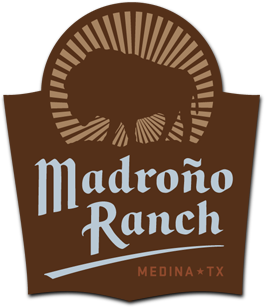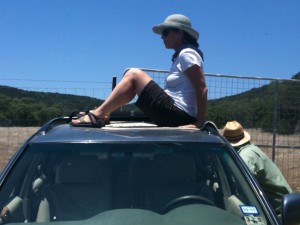This is a bird-and-bison-intensive kitchen sink of a blog post; even Martin’s most focused editorial ministrations will be of no avail in trying to flush out some kind of narrative thread. To lend it at least an illusion of coherence, I decided to title it “Field notes from Madroño Ranch.”
* * *
Every April the barn swallows and purple martins return to the ranch; the barn swallows tend to congregate at the Lake House, and the purple martins tend to congregate at the Main House. They all inhabit the fabulous mud nests constructed by the swallows: how do they do they build these elegant constructions with no hands? Under one of the eaves of the Main House there are probably sixty or seventy condo units, many currently filled with fledgling martins and swallows. The business of feeding all these babies keeps the parents very, very busy, swooping their great athletic loops in search of insects.
The swallows have constructed one nest on a tin light fixture on the ceiling of the breezeway outside the Main House front door. Every summer I have to train myself not to turn that light on when I head to the garage or down to the Chicken Palace at night, since it panics the nest’s inhabitants. This year’s fledglings will probably be gone by the time you read this; they’ve already learned to fly from and return to the nest, and their three bulky adolescent bodies fill the sturdy little construction to overflowing. Last week, a little late putting the chickens up in the evening, I headed down to the Palace with a flashlight and thought to look up at our nesting guests. Both of the parents were draped across the top, like a too-big feathery lid on a small pot, protecting their babies from night dangers and getting a little rest after chasing mosquitoes all day for their wide-mouthed brood. I know anthropomorphism is out of fashion, but it was a sweet, intimate scene.
* * *
As we near the end of the bison calving season, we’ve had eight calves on the ground so far and are hoping for two more. Unfortunately, one calf has died, and we don’t know why. Robert and Tito (who’s working at the ranch until the beginning of the second summer session at UT) noticed something unusual about the calf’s head after it was born but couldn’t get close enough to see what the anomaly was, and it died within a week of its birth. When we went to the spot where it died, to see if we could find any clues as to the cause of death, nothing was left except for some pelvic bones, a couple of vertebrae, and one tiny hoof. The scavengers had done their job quickly and efficiently.
The other calves seem to be thriving, despite the drought. Like almost all babies, they’re awfully cute: biscuit-colored and about fifty to sixty pounds at birth. That sounds big until you see them milling around the pickup with the grownups at cube-feeding time, a ritual that seems particularly important now that there’s so little grass. We saw one little guy come out of the melee with a very bloody nose, perhaps from a well-placed kick from a larger relative (even bison have their pecking order). It was a pathetic sight, but he seemed to recover by the following day.
Bison will eat just about any vegetable matter in a drought, unlike their more finicky bovine cousins. Our friend Hugh Fitzsimons of Thunder Heart Bison told me recently that their herd has been eating a lot of mesquite beans and cactus. I’m not sure what ours are eating to keep themselves going; I hope it’s cedar, at least as an hors d’oeuvre.
* * *
We’ve had a steady stream of guests and residents at the ranch recently, several of whom have been enthusiastic bird-watchers, which is a real boon for me. One morning our friend Brian Miller and I went out to see who we could find flitting around. Brian, admitting that he prefers his birds to be showy, particularly hoped to see some painted buntings. It was very windy, which made for a quiet morning, bird-wise, although we got some impressive clattering from a pair of belted kingfishers and an unusually good goggle at a golden-cheeked warbler. As we stood on a little bluff above a creek whose banks are crowded with sycamores, I saw Brian peer at something through his binoculars. It was an indigo bunting so blue—ranging from mountain gentian blue at the head to almost turquoise around the tail—that Brian thought at first that it was a piece of plastic stuck up in the tree. Too blue to be true—sounds like a country song! We definitely got our show.
* * *
The cows we think are still pregnant have that fully stuffed look, especially when they’re lying down. The mama who lost her calf now has her yearling nosing at her udder again, so all the mature cows are feeling pretty protective—one of the several things that worried us about releasing the new bull into the herd. We brought him onto the ranch almost a month ago, and he’s been acclimating in the retention pen, a high-fenced area that incorporates about thirty acres. T. D., the incumbent bull, has been hanging out by the retention pen gate for weeks, rolling and kicking dust through the fence at the newcomer and then settling his great bulk where the new guy could see him. The cows have been checking him out as well. Bubba and Dixie, the llamas, who are full-time residents of the pens, looked down their long noses at the hulking arrival and kept their distance.
We’d been speculating about what would happen when we finally let the new bull (whom we’ve tentatively named T. A.) out, which we did last Sunday afternoon. He and T. D. are about the same size, but T. A. seems to be taller at the hump, with a bigger head, although he’s slimmer than T. D., who’s built like a tank. We envisioned a clash of titans and worried about blood and guts and trampled calves and crazed mama bison and ripped-up fencing; I prudently planted myself on the roof of my car (see photo above), in case things really got out of hand.
Turns out we needn’t have worried. T. D. was nowhere in sight when we opened the gate, and the first thing T. A. did after moseying out of the pen was to wander over to some nearby cedar and sycamore saplings and maul them with his horns, just to show them who was boss. Then he set off up the hill, leaving us to follow helplessly in the pickup, wondering how long it would take him to break through the wimpy fencing that separates us from our neighbors. After he abruptly veered off the road and into the underbrush (how can something that big just vanish?), we headed back down for a brief break from the scorching dry heat.
An hour or so later, we found him near the top and managed to direct him back down the hill and into the creek, where the cows finally spotted him. T. D. was lurking in the underbrush above the creek and, to our surprise, made no move to confront him. The new guy kept his tail up and hooked as the cows investigated him, although judging by his sniff-and-grin, chop-licking expression he was clearly pleased to be in the midst of so much shapely feminine flesh.
When T. D. finally emerged, it was clear that there wasn’t going to be a showdown: T. A. had so intimidated him that T. D. wouldn’t even meet his gaze. Each time the new guy approached, tail up, T. D. walked away. Each time T. A. pawed the dust or rolled, T. D. turned his back. We were all a little embarrassed for him. But breeding season is coming up: maybe the fight is yet to come.
* * *
For Martin’s birthday last Saturday, we engaged the expertise of Tink Pinkard, fly-fishing guide and teacher extraordinaire. With unflagging patience, he coaxed us into finally feeling the load of the line as it unfurled over our heads and allowed us to imagine that we were starting to get it. On Sunday morning we quit the creekside to putter around the lake in Tink’s doughty (and slightly leaky) johnboat. We actually caught a number of sunfish and a nice little bass, but mostly we caught sight of what a really beautiful cast looks like. Watching Tink with a rod in his hand was like watching a particularly eloquent sign-language speaker when you only know the alphabet; his movements were powerful, fluent, efficient. I want to talk like that.
Now I have another outlet, beyond bird-watching and rowing, for my capacity to hyper-focus. I was hoping that fly-fishing and bird-watching would be less mutually exclusive than rowing and bird-watching, but, alas, my hopes were dashed. Each time I allowed a passing bird to distract me in mid-cast, my line snarled, wrapping around itself, the rod, and, occasionally, me. I briefly worried that I might get so tangled that I would end up casting myself out of the boat and into the water. Many long-time Madroñoites have caught glimpses of The Thing, the enormous… what? fish? dinosaur? that occasionally rises from the murky depths of the lake, so I’m determined to stay focused on the casting. At least until the green kingfisher reported by one of the residents shows up again.
What we’re reading
Heather: Phyllis Rose, Parallel Lives: Five Victorian Marriages
Martin: Lewis Hyde, The Gift: Creativity and the Artist in the Modern World (still!)

